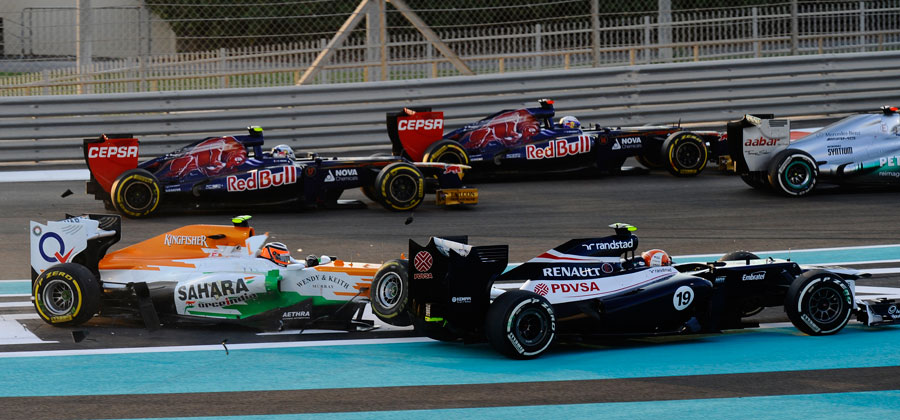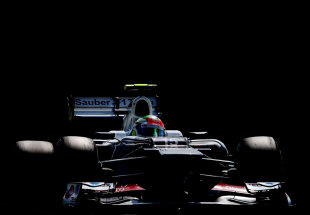- 2012 Teams Review
The winners and losers of 2012

- Teams:
- Alfa Romeo
- |
- Caterham
- |
- Ferrari
- |
- HRT
- |
- Lotus F1
- |
- Manor
- |
- McLaren
- |
- Mercedes
- |
- Racing Point
- |
- Red Bull
- |
- Toro Rosso
- |
- Williams
Team of the year - Red Bull
Red Bull has become a study in how to run a Formula One team over the past few years. Since the last major regulation changes in 2009, the cars from Milton Keynes have consistently broken boundaries and the team has been rewarded with three constructors' titles and three drivers' titles.With a set of technical regulations 77 pages long, Formula One has become a search for grey areas followed by a race to exploit them. In Adrian Newey, Red Bull has a man willing to push to the limits of what is allowed, giving not only his rivals a tough job of keeping up but also the FIA.
At the start of 2012 the team struggled with the new restrictions on exhaust blowing, and the RB8 was not the car the team had envisaged when Newey first put pen to paper. Several ideas were quickly stamped out by the FIA in the early half of the season, but by the second half Newey and his designers had tapped a rich vein of performance from the rear of the car and it proved decisive in the championship.
Newey later described the start of the year as "frustrating" while team principal Christian Horner was fighting his own battles with the other teams over the future of the sport. Ultimately, Red Bull came out on top in almost every aspect and that is a tribute to Newey's leadership of his fantastic technical team as well as the guidance from Horner at the top.

Best recovery - Ferrari
Much was made of how poor the F2012 was this season, but very quickly it went from being two seconds off the pace in testing to a match for all bar Red Bull in race trim. The exhausts were the big problem area, but the car had many other flaws too and they were accentuated by a continuing lack of correlation between wind tunnel and track.
With Fernando Alonso at the wheel the Ferrari was always going to be a threat to the top three positions at every race weekend. However, to say it was solely Alonso's brilliance that put the car there would do a great disservice to the team.
Strategies were almost always perfect (save for the call to stay out on old tyres in Canada which saw Alonso plummet from first to fifth in the final six laps), and reliability bulletproof. The one time there was a problem with the car was a suspension failure on Alonso's car in qualifying at Monza, but the team displayed all of its recovery skills in one grand prix to go from tenth to third in the race.
Watching testing in March, the McLaren was streets ahead of the Ferrari in terms of pace - both short and long-run - but that Ferrari took second in the constructors' championship displays just what immense progress was made across eight months.
The bottom six

- Force India: The usual story of starting with a good base and developing the car to become more competitive later in the season. Hulkenberg could have given the team its first win in Brazil and will be missed in 2013, but di Resta will step up after solving the chassis problems that hampered him in the final races.
- Williams: A return to form, and most importantly a return to the top step of the podium in Spain, was proof that the changes in the technical staff had paid off. However, its drivers flouted as many opportunities as they took and ultimately the car was capable of finishing much higher up the order at most races.
- Toro Rosso: A new, fresh line-up had little chance to impress in a car that was consistently lacking in outright pace. Both drivers deserve a second chance, and James Key's arrival should see the team making progress next year.
- Caterham: Vitaly Petrov's 11th place in Brazil was all that stood between a mediocre and a disastrous season for Caterham. The objective of scoring points wasn't met but the hope is that the move to a new factory in Leafield means 2012 can be written off as a transitional year.
- Marussia: Came so close to holding on to 10th in the constructors' championship but fell at the final hurdle. Glock's consistency allied with that all-important KERS should see the team really fighting it out with Caterham and the impressive Charles Pic next season.
- HRT: Both cars failed to qualify for the first race, but with the resources its effort in 2012 wasn't bad. By the end of the year it became clear that the future was not looking bright and races became opportunities to attract investors rather than attempts to be competitive. The team may not be hugely missed in 2013, but it's a worrying sign for F1 that the grid is shrinking once more.
Biggest disappointment - McLaren
The main failing that McLaren has lamented in recent seasons is its inability to start the year with the fastest car. 2012 finally gave it that platform as it secured a front-row lockout and 1-3 result in Melbourne (which should have been a 1-2 but for an unlucky safety car) and another dominant qualifying showing in Malaysia. However, that was as good as it got until Lewis Hamilton won in Canada.
The intervening time - and a few races after too - was filled with uncompetitive performances as McLaren failed to get the car working properly and hit numerous pit-stop problems. It appeared to be a downturn in form, but ultimately back-to-back victories in Belgium and Italy showed that the potential was always in the car, just not being unlocked.
Once the team started to understand how to get more out of the MP4-27, reliability issues reared their heads. Hamilton should have won in Singapore and Abu Dhabi, and also should have scored more points in both Japan and Korea. Perhaps his usually aggressive driving style doesn't help matters compared to team-mate Jenson Button, but had the car not let him down Hamilton would have certainly been in the title mix come Brazil. Red Bull might be very strong, but McLaren should have beaten Ferrari quite comfortably. Despite having the fastest car, it was a case of the same old story as McLaren ultimately made it 14 years since it won a constructors' championship.
Back on track - Lotus
Even the Lotus engineers were a little bit surprised by the potential the E20 showed during pre-season testing. There was no way of knowing whether it would turn out to be a race-winning car until the first race at the earliest, but even though the team had to withdraw from the second test due to a suspension issue, the new Lotus was clearly quick.The car continued to deliver during the first half of the season and Lotus managed to keep pace with the top teams. As the paddock went its separate ways ahead of the mid-season break there was a genuine feeling that Kimi Raikkonen, who had come close to winning in both Bahrain and Hungary, could challenge for the title. However, on the return in Spa it was clear that the big three - Red Bull, McLaren and Ferrari - were starting to get their acts together and it became more and more difficult for Lotus to hang on.
The car was quick enough on race pace, but on qualifying pace it was falling into the clutches of the midfield and that was holding Raikkonen back and saw Romain Grosjean get caught up in a number of accidents. All too often the true pace of the Lotus couldn't be unleashed, but in Abu Dhabi Raikkonen qualified well, Lewis Hamilton's McLaren failed and Lotus got the win it deserved.
There's little doubt that if the car had been challenging for the front row more often - Raikkonen didn't qualify in the top two once this year - then a championship was on the cards. It was a matter of tenths, but in 2012 tenths were crucially important. Nevertheless, the team from Enstone is back on form and could be a genuine challenger in 2013.

Underachievers - Mercedes
By its own admission, Mercedes had another disappointing year in 2012. On the plus side it won its first race since returning as a constructor in 2010, but the slide of form in the second half of the season took the shine off the win by the end of the year.In the opening races it became clear the W03 could be competitive, but a complete misreading of how to treat the tyres in the first two races led to huge disappointment. In China it hit the sweetspot with Nico Rosberg taking a dominant pole position and victory, but from that point onwards it never clicked in quite the same way.
After the Monaco Grand Prix, which a Mercedes should have won, the downturn was more dramatic as the car lacked downforce at the rear and was hard on its tyres. Its rivals were starting to develop Coanda exhausts to recover rear-end grip, but Mercedes was struggling to get its own system working. Matters weren't helped by a wind tunnel upgrade that stunted the team's development, but ultimately it was going round in circles while its rivals made huge strides forward.
By the time Lewis Hamilton had been announced as a driver for 2013 - Mercedes' most impressive achievement this year - it was clear that the focus had shifted to next season. The 2012 campaign was written off as another transition year, but the preparations need to start paying off soon as slipping to fifth in the constructors' championship was not part of the plan.

Surprise package - Sauber
From an early stage in pre-season testing it appeared Sauber had a quick car, but there were two factors tempering the optimism. Firstly, the team had a lack of obvious main sponsors on the car and in 2011 similar headline times were set on low fuel in an attempt to attract potential investors. Secondly, the man who had penned the C31 - James Key - left the team before the season had begun, and if the car was indeed that fast, how would Sauber keep it that way?
Melbourne didn't show the car's pace, but Malaysia certainly did. In the hands of Sergio Perez the team was on the brink of a famous victory but he eventually had to settle for second behind Fernando Alonso. On that weekend the car was the quickest of the field over a race distance, and the key was in getting the Pirelli tyres to work. By having a car easy on its tyres and able to keep them in the optimum operating window for as long as possible, the pace could be exploited.
Further podiums for Perez in Canada and Italy - where he again threatened to win - were added to by Kamui Kobayashi's brilliant third place at his home race in Japan. The podiums weren't the surprise, though, the overall pace of the car was. Ultimately, Sauber should have done much better than just four top-three finishes, and perhaps that's the thinking behind Kobayashi's replacement.

